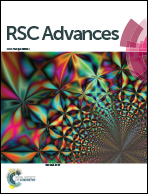Degradation and regeneration of hybrid perovskites†
Abstract
A hybrid organic inorganic perovskite, CH3NH3PbI3, has been deposited, using a two-step deposition technique, on three different substrates: bare FTO and two different types of TiO2 electron transport layers. These structures have then been monitored, using XRD, for degradation under exclusively ultraviolet (UV) and visible light. It has been observed that the topography of the underlying substrate is shown to impose a substantial effect on the particle size of the HOIP phase that gets deposited on top. Furthermore, subsequently it has been observed that the particle size, the level of crystallinity and also type of irradiation (UV vs. visible light) all are important parameters that substantially influence the rate and manner of degradation of HOIPs. These are in addition to the oft-cited parameters such as moisture, O2 and temperature. Moreover, depending on the level of degradation, it has been intriguingly observed that the HOIP phase can be regenerated upon a simple treatment involving I2 deposition. This latter aspect has the potential to circumvent the deleterious degradation that is hindering further progress with this highly promising material.


 Please wait while we load your content...
Please wait while we load your content...